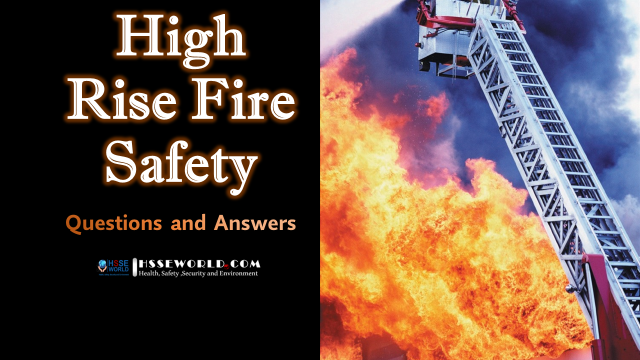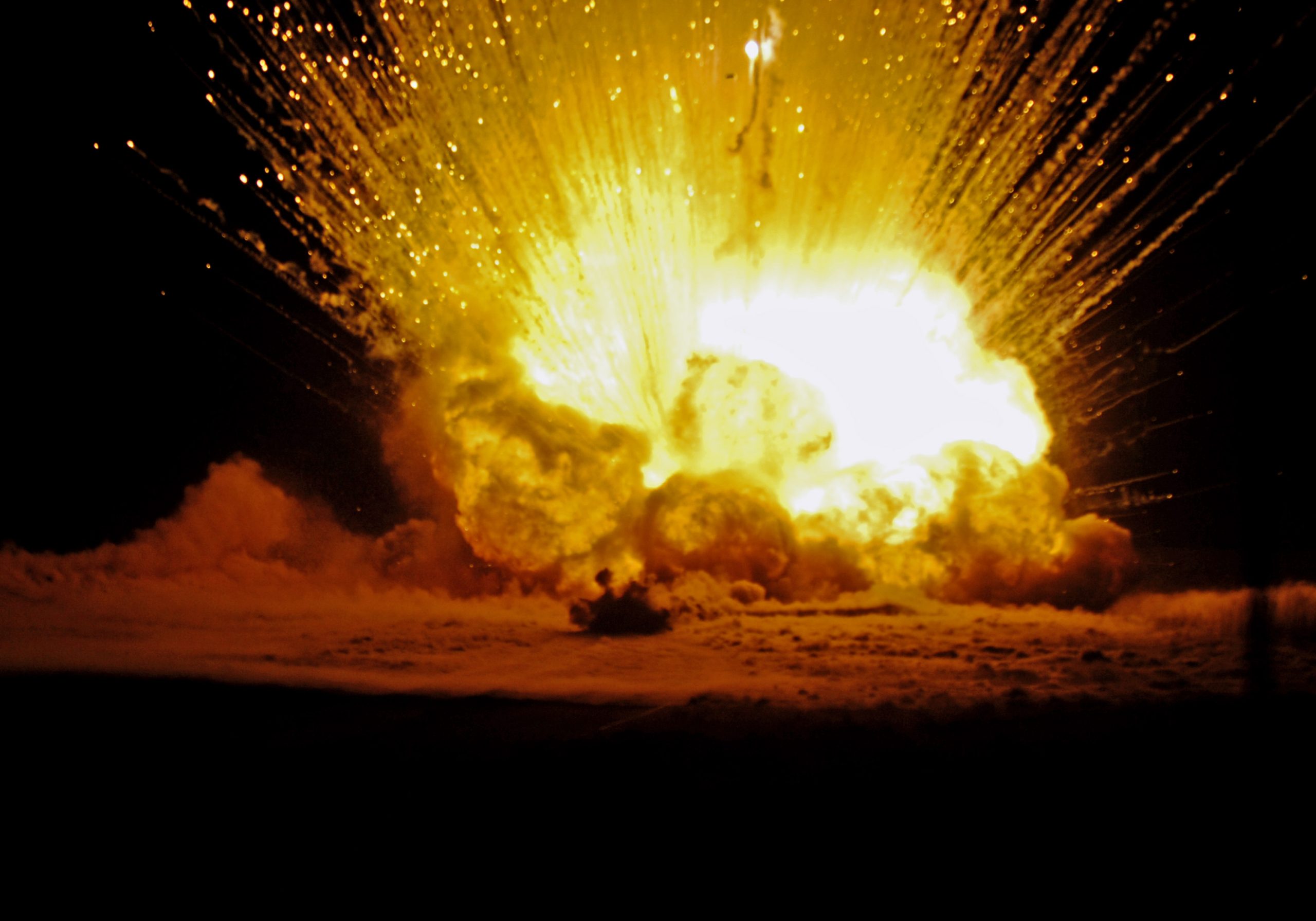Several recent fires in high-rise buildings have awakened renewed interest in fire safety on the part of the public, and in particular, apartment dwellers. Since most high-rise buildings are of fire-resistive construction and possess reliable enclosed stairways, fires are generally confined to individual office furnishings or possibly the contents of one floor.
Thus, it is important first of all to understand that fire in a high-rise building is not necessarily a cause for panic. Nevertheless, it must be realized that if a fire occurs within a building, it will most likely be necessary to seek refuge as soon as possible. Therefore, it is extremely important that the occupants become well acquainted with the location of stairways provided in buildings and with the procedures to follow in case of fire.
Also Read: E-Books: Principles Of Fire Risk Assessment In Buildings

Q. Is there a requirement for building owners/operators to hold regular emergency drills for occupants?
- According to the “Life Safety Code 101” Section 4.7.2. and Section 39.7.1, emergency egress and relocation drills shall be conducted in “all business occupancy buildings that are occupied by more than 500 persons or by more than 100 persons above or below street level whenever practicable”. The following industries specifically are required to instruct employees and hold drills whenever practicable:
- Ambulatory health care facilities;
- Detention and correctional facilities;
- Day care centers;
- Educational institutions;
- Hotels and dormitories;
- Markets;
- Residential boarding and care facilities.
Q. Is high-rise building evacuation different from other buildings?
Also Read: Basic Guidelines for Selection of Fire and Gas Detectors
- Evacuating multiple floors of a high-rise building involves requiring a lot of people to travel great vertical distances on stairs. In the 1993 bombing of the World Trade Center, for example, we learned that in some cases it took as long as six to eight hours for occupants to exit the buildings. The physical demands made on high-rise occupants exiting via stairwells can exceed many people’s capabilities. The fire and life safety systems installed in high-rise buildings today, including automatic fire sprinklers, are designed to control a fire and therefore lessen the need to evacuate all occupants. In a typical scenario, the occupants of the fire floor and the floors immediately above and below it should immediately use the exit stairs to descend to a floor level that is at least several floors below the fire floor and await further instructions from safety officials. Remember, these building systems are designed to control a typical fire; not one caused by a commercial airliner crashing into the building.
Q. Under what circumstances may I use the elevator safely?
- It is never appropriate to use the elevator during a fire or similar building emergency, even in a two-story building. When a fire occurs, elevators are designed to be recalled to a designated floor, normally the lobby. However, in some circumstances, an elevator malfunction may cause the elevator to travel to the fire floor itself, thus exposing occupants to the fire. Smoke might also be from elevator shafts or any other vertical shaft in a building and migrate toward the roof of the building. If employees are in the elevator and there is smoke in the shaft, they will be exposed to it.
Q. If exiting downstairs takes so long, am I better off going up to the roof and waiting to be rescued there?
- No. Using helicopters for roof rescue is an extraordinarily dangerous procedure for the occupants, pilots, and firefighters who may be in or around the building. In severe fires, the large thermal currents, generated by the heat from the fire, can cause the helicopter to be buffeted up or down, making it hard to control. The down thrust from the helicopter rotor can force smoke and superheated air on top of fire suppression personnel. Consequently, ascending to the roof may prove to be a waste of valuable time, since it may be impossible for a helicopter to approach the roof. Most building designs incorporate features that direct occupants to the street level during evacuations.
Q. Should my building have any type of exterior escape device?
- Items such as escape chutes and controlled descent devices are permitted by the Life Safety Code to provide escape routes in special structures, such as some towers and special manufacturing environments. They are not permitted nor recommended by U.S.-based codes for commercial and public buildings. Such devices do not provide the same level of protection as other code-mandated features.
Q. How are emergency instructions tailored to the actual emergency event and communicated to building occupants?
- High-rise building fire alarm systems are required to have emergency voice communication. Trained emergency personnel assess the emergency and broadcast a variety of specific messages to the occupants. The occupants believed to be in the greatest potential danger are instructed to use the exit stairs to begin their descent. Occupants of other floors might be instructed to stay where they are and await further instructions. Typically, only occupants on the fire floor and the floors immediately above and below receive the announcement through the system. Should the scale of the emergency increase, the announcements will include additional floors, or the entire building if necessary.
Q. If I stay and then the situation becomes dangerous and I am trapped, should I break a window? Should I jump?
- If you are trapped in a high-rise building, try to locate yourself in an area where you can close the door and seal the cracks to keep smoke out. Use a telephone to call the fire department and report your exact location in the building. Try to be patient. Emergency rescue of high-rise building occupants can take a long time. You can signal your position to rescue personnel from a window using a light-colored cloth, but it is not advisable to break a window. If you can open the window slightly, it is generally safe to do so to allow fresh air in, but be prepared to close it if smoke comes in. A broken window cannot be adjusted to block smoke from pouring in. Finally, falling glass from a broken window can sever fire hoses and severely injure rescue and suppression personnel below. It is very dangerous to use a window to escape from anything higher than the second floor.
Q. Will the systems work in a terrorist attack?
- Prior to the events of September 11, 2001, a suicide pilot of a jetliner was not a credible or foreseeable building design hazard. Systems work under normal fire conditions. Current building evacuation or relocation procedures consider the need to move occupants from harm’s way with a fire that grows in a very predictable way and at a rate that is typical of the anticipated fire hazards in buildings.
Q. How can I judge if my building’s evacuation plan is adequate for any emergency?
- It is highly likely that the procedures are adequate. In our society, we plan on events that are likely to happen in a building or structure. In large part, evacuation procedures are geared toward fires occurring in buildings. Your building’s evacuation procedures should make clear to you and all occupants the actions you are to take, and when to take them. In addition, evacuation plans and routes should always be posted and emergency response drills conducted at least once a year. Buildings are required to periodically test fire safety systems as well.
Also Read: 6 Common Fire Sprinkler Myths
Q. What procedures apply to people in a wheelchair or with other disabilities that affect mobility?
- Able-bodied, as well as disabled occupants, must be covered under any written procedures. If your area has to be evacuated, you should plan to relocate. In buildings with automatic fire sprinkler protection, this may simply be to an adjacent compartment or office space. In other cases, your building may be provided with special areas of refuge. These areas may be stand-alone, fire-resistant compartments on the floor, or they may consist of oversized landings in stairwells. Regardless of which feature you have, your plan includes waiting in one of the designated spaces until fire department personnel can relocate you. Oftentimes, these spaces are provided with a two-way communication device so you can give rescue personnel your location. Your work environment may also supplement this procedure with a “buddy” system, in which case you need to anticipate situations where the “buddy” may not be available in an emergency. At any rate, regardless of one’s abilities, if you have any questions about your building’s plan or how you fit into it, you should ask your employer for detailed information and request that those with disabilities have a role in crafting the plan.
Q. If the neighboring high-rise is on fire, should my building evacuate?
- Not during a typical fire. You should remain vigilant to determine if there is any change that could result in your building being threatened. In such cases, emergency personnel has adequate time to order evacuations of other buildings.
Q. What happens when the event is not typical?
- Safety is everyone’s business so we all must take a certain amount of personal responsibility. Standard operating procedures, verbal instructions, and even past experience may not be adequate or appropriate in dealing with extraordinary events. A good guideline to follow is based on the acronym, RED:
React: Take any indication of smoke, fire, or other threat seriously.
Evaluate: Judge the level of the threat by confirming evidence, conditions, and available information.
Decide: There are only two choices, both difficult.
- Immediately leave the building.
- Stay where you are or descend to the designated level below the fire floor and prepare to take protective or defensive measures.
Remember to practice safety. Don’t learn it by accident.
Also, Read: E-Books: Safety identification: Escape and evacuation plan signs- ISO 23601
Please visit our Safety Resources SAFETY BAG to have many Safety Resources





